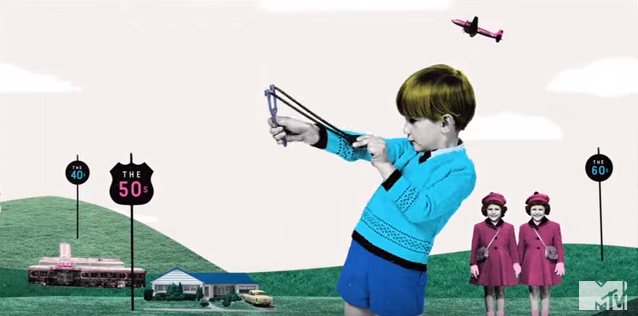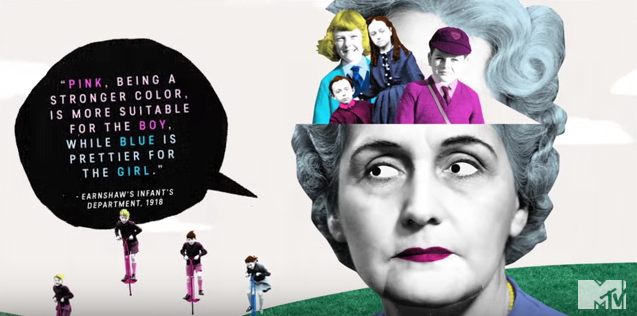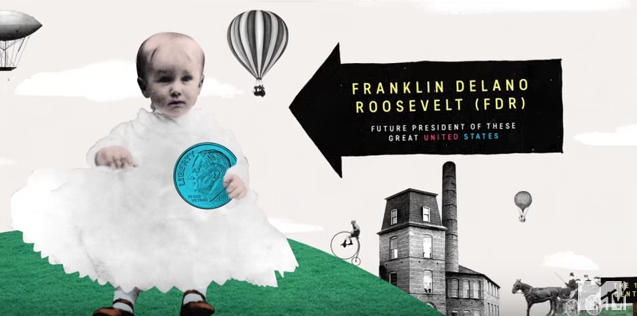These Animations Call B.S. On Society's Gross View of Children's Toys

By:
We tend to think of boys donning dresses or sporting pink as boldly defying gender stereotypes, but this wasn't always the case. The new MTV video campaign, "Gender Bent: The Questionable History of Gender Norms," explains how we arrived at today's pink and blue world, and just why color-specific gender norms are so absurd.
 Youtube/MTV - youtube.com
Youtube/MTV - youtube.com
Pink and blue weren't assigned to gendered children's toys and clothing until the 20th century, the video points out, and the colors' roles were initially reversed. A 1918 article from trade publication "Earnshaw’s Infants’ Department" stated, “Pink is for the boys, and blue for the girls. The reason is that pink, being a more decided and stronger color, is more suitable for the boy, while blue, which is more delicate and dainty, is prettier for the girl," Smithsonian reported.
 Youtube/MTV - youtube.com
Youtube/MTV - youtube.com
Some famous men in history even wore dresses.
MTV also pointed out that before the 20th century, both male and female children wore dresses. "For centuries, all children wore fully white dresses," MTV host Nessa, who narrated the video, said. "Boys, girls, and even future presidents."
 Youtube/MTV - youtube.com
Youtube/MTV - youtube.com
How the world went pink and blue
Pink wasn't always a prominent or definitive feature of women's fashion. "We think of pink as such a girlish color, but it's really a post-World War II phenomenon," Michelle Finamore, who curated "Think Pink," an exhibit on the color's fashion history, at Boston's Museum of Fine Arts, told NPR. But pink was initially considered the more masculine color, "because it's a stronger and more passionate color, and because it's actually derived from red," Finamore said.
Pink wasn't associated with female clothing until the 1940s, the MTV video notes. The color became linked to femininity after World War II, according to Smithsonian, due to "Americans’ preferences as interpreted by manufacturers and retailers." Jo B. Paoletti, a University of Maryland historian and the author of "Pink and Blue: Telling the Girls From the Boys in America," told Smithsonian that the distinction was arbitrary. “It could have gone the other way,” she said.
Pink and blue began to accrue the gendered invocations they maintain today amidst post-WWII cultural shifts, NPR reported. "When the war ended and the men came home, Rosie the Riveter traded in her factory blues for June Cleaver's pink apron," NPR special correspondent Susan Stamberg observed. "In the postwar ideal, men reclaimed the workplace, and women stayed home with babies and shiny appliances. Femininity got wrapped in pink, and so did products — from shampoos to fancy fashion."
The gender-toy bias
As ATTN: has previously reported, studies have looked at how gendered toys shape children's attitudes, interests, and identities. A 2008 study by professor Becky Francis found that male 3-to-5-year-olds' favorite toys revealed interests in mechanics, construction and building, while girls' toy preferences did not. Francis concluded that toy bias may contribute to less women entering mathematics later in life.
Companies that have released gender-neutral toys have seen mixed responses on social media. After Target announced that it would be removing gender barriers in its stores, Facebook user Mike Melgaard posed as a Target customer service representative and used his profile to troll users who threatened to boycott the shopping chain.
Melgaard told Adweek that he supported the company's choice to push back against gender stereotypes, though his prank was "more about laughs."
"I absolutely love satirical humor, and I think America could use a little more laughter," he said. Still, some shoppers took serious issue with Target's policy change on Twitter.
Others voiced their approval of Target's gender neutral move and Melgaard's antics on Twitter.
To learn more about the history of gender stereotypes, you can watch all three installments of "Gender Bent: The Questionable History of Gender Norms" on MTV's Youtube channel.
